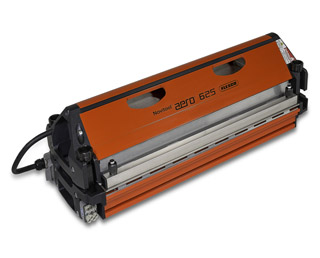Air-Cooled vs. Water-Cooled Splice Presses – Which Is Best?
July 10, 2018
 Air-Cooled vs. Water-Cooled Splice Presses – Which Is Best?
Air-Cooled vs. Water-Cooled Splice Presses – Which Is Best?
Conveyor belts never fail when you have plenty of time to fix them; they always fail when you are up against a deadline or pushing to get that order out. So when everything is counting on getting your belt conveyor up and running again, what kind of splice press will help you get the job done? Air-cooled or water-cooled?
Where does cooling fit into the process?
First, it’s important to recognize why cooling the conveyor belt, and how you go about doing it, is so important. Whatever endless splicing method you choose follows a similar process when it comes to heating – it applies heat and pressure to melt your thermoplastic belt and then fill the voids to join it. However, when it comes to cooling, time is the key factor because overcooking and other heating factors can cause weakened splices and premature cracking. That’s why the cooling process needs to be completed as quickly as possible after the splice has been joined.
It’s at this point in the process where air-cooled presses and water-cooled presses are different.
Water-cooling
The traditional method of water cooling uses water as a very effective cooling agent. The cold water quickly brings down the splice temperature. But as it continues to cool, the process begins to slow. In the case of large water-cooled presses, this process slows even more quickly as the water must also cool the large aluminum splicing platens along with the splice. The average cool down for a water-cooled press takes about 10-20 minutes.
Water-cooled splicing also involves the press operator finding a water source onsite or bringing water with them. Water tanks need to be filled and hoses attached before beginning the splicing process, and after completing the splice. In some cases, filling tanks and transporting water may even be considered unsanitary and more time may be needed to sanitize equipment to prevent against water-borne bacteria being introduced to the environment.
Air-cooling
Small, lightweight, air-cooled presses use fans to cool the splice, bringing significant time savings to the splicing process. The forced-air presses are designed with less mass, meaning less time to cool the platens and the splice. Time is also saved because no external components need to be set up or taken down since water is not used.
Efficient air-cooled presses can cool down in three to five minutes and can be set up or taken down quickly since no external components are used to feed water into them. The other benefit of an air-cooled press is that they are often preferred by crews to take onsite because they weigh less and are easier to transport and handle.
For more information on Flexco’s air-cooled splice press solution, the Novitool® Aero® Splice Press, click here.
Authored by: Michelle Graves, Product Manager
Graves manages the overall global business, market plans, technical support, and activities associated with the light-duty belting market for the Novitool® product line, including new product development, market analysis, and global strategy. Graves holds a bachelor’s degree from Albion College as well as a master’s degree from Grand Valley State University.
Subscribe to the Flexco Blog
Published Date
July 10, 2018Product Group
- Endless Splicing Systems
Issue
- Downtime
